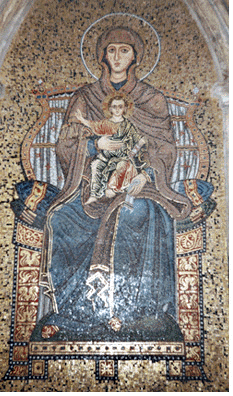...Best of Sicily presents... Best of Sicily Magazine. ... Dedicated to Sicilian art, culture, history, people, places and all things Sicilian. |
by Luigi Mendola | |||
Magazine Index Best of Sicily Arts & Culture Fashion Food & Wine History & Society About Us Travel Faqs Contact Map of Sicily
|
Ravenna, Venice and Apulia were rapidly becoming Latinized. The Norman kings of Sicily, and their descendant, the oft-excommunicated Frederick II, were "Papal Legates" empowered by the popes of Rome to confirm the papal choice of Sicilian bishops. The Norman rulers of Sicily, beginning with Robert de Hauteville and his younger brother, Roger I, worshipped in Byzantine churches, but papal approval of their conquest of Sicily from the Arabs was predicated on their fealty to Roman, not Greek, Christian ecclesiastical authority on the island. In 1061, when the Normans landed at Messina, the effects of the recent Schism between Rome and what soon became known as the "eastern" churches, were just beginning to be felt. The theological issues are well known, and the artistic ones (relected in works like the icon at Taormina shown here) evident enough. By 1300, Sicily was thoroughly "Latin," with few Orthodox Christians or Muslims remaining. With few exceptions (such as Frederick II's exile of some Muslims to Puglia), there were more conversions than emigrations. For Christians, it was a simple matter of ecclesiastical jurisdiction, as Orthodox bishops were replaced by those loyal to Rome. The spirit of the Inquisition, with all its horrors, eventually forced the conversion of Jews as well. The full flower of Sicily's great multicultural experiment, demonstrating the epitome of religious acceptance, had lasted for less than two centuries. How did Orthodox monasticism survive in northeastern Sicily for another century, until almost 1400? The simple answer is that Orthodox monasteries in places like San Marco d'Alunzio (which has a small but interesting museum of medieval Byzantine art) and Alcara Li Fusi were somewhat remote, isolated even by Sicilian standards, reached by winding mountain trails. But there's also a political reason. For several decades during the fourteenth century, though Sicily was nominally ruled from afar, a period of feudal chaos at home, resulting in effective localized control by several prominent noble families (the Chiaramonte clan comes to mind), meant that abbots were relatively free from the direct influence of Rome. The situation was further fostered by frequent papal interdict, a condition that actually encouraged the independence of local clergy. In every way, the Nebrodi and Peloritan regions were remarkably undisturbed; a few deer (now extinct) still roamed their extensive forests. While this part of Sicily was not without its local barons, monastic authority was at least as strong as theirs. In effect, the arrival of the overwhelming theological and social influence of Rome was delayed. This meant that Latin and Byzantine monasteries existed side by side. More frequently, the evolving Latin religious communities, while faithful to Rome, maintained typically Orthodox traditions (icons, Byzantine liturgy and vestments) as long as they could. So for a time some of the monasteries of northeastern Sicily were more Orthodox than Catholic, existing in a kind of transitional stage until the early years of the fifteenth century. Messina and Taormina were, in a sense, the hearts if not the soul of eastern Sicily's late-medieval Christian Byzantine culture. The former was locked in a constant battle for importance with Palermo, the island's capital, and enjoyed a certain international prestige of its own as a gateway to the East. Taormina, traditionally a center of monasticism, still looked to Greece for its spirituality. The Renaissance arrived. Baroque churches eventually supplanted Byzantine ones, though an influx of Scanderbeg's Albanian refugees from Turkish raids brought a few Orthodox Christians to Sicily, where some towns have both "Latin" and "Greek" parishes. (Today, the Albanian Rite church is actually Roman Catholic, but its origins are clearly Orthodox.) Artistically, it is the icons in Palermo's Palatine Chapel and Martorana Church, and in the cathedrals of Cefalù and Monreale, that best represent Sicily's Byzantine heritage. But eastern Sicily is not without its jewels. About the Author: One of Sicily's foremost historians, Luigi Mendola is the author of two books. | ||
Top of Page |
 Historians only occasionally allude to the fact
that northeastern Sicily, and particularly the religious communities nestled in its wooded
Historians only occasionally allude to the fact
that northeastern Sicily, and particularly the religious communities nestled in its wooded